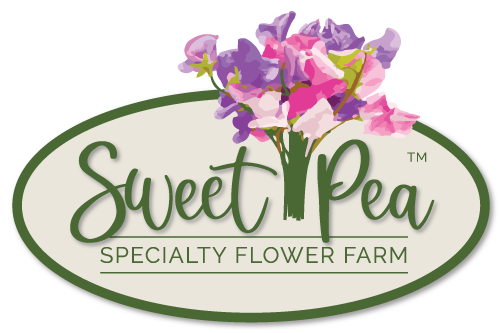
(781) 812-4018
61 Morse Road
Plymouth, NH, USA 03264

(781) 812-4018
61 Morse Road
Plymouth, NH, USA 03264
Sweet Peas (properly called Lathyrus odoratus) are one of the great plants for cutting, and they provide irresistible colors and fragrance for spring and early summer bouquets. The delicate flowers are available in a wide range of rich colors, and they scent the air with grape-like perfume. Sweet peas are native to Sicily, southern Italy and the Aegean Islands. It is an annual climbing plant, growing to a height of 1–2 meters (39.3 – 78.5 inches), where suitable support is available. In the wild plant the flowers are purple, 2–3.5 centimeters (0.79–1.38 inches) broad. Domesticated sweet peas are larger and come in a very wide range of colors.
Sunflower (Helianthus) is a genus consisting of about 70 species of annual and perennial flowering plants in the daisy family. Except for three South American species, the species of Helianthus are native to North and Central America. The common sunflower typically refers to the popular annual species Helianthus annuus, whose round flower heads look like the sun. It typically grows during the summer and into early fall, with the peak growth season being mid-summer.
The most popular of all woody plants for cut-flower growers are in the genus Hydrangea. Although there are eighty-some species, only a few are grown for cut flowers, primarily H. arborescens, H. paniculata, and H. macrophylla. The fertile flowers are small and inconspicuous, while the sterile flowers larger and showier, with petal-like sepals. It is the combination of sterile and fertile flowers that determine the look of the panicle (a loose branching cluster of flowers), either airy or solid. They are easy to grow as long as you plant the right varieties in the right location and prune at the right time. Most prefer afternoon shade when the temperature is above 85°F (29°C). Commercially, they are usually grown under shade conditions. We grow ours on the edge of the forest beneath the trees.
Herbaceous peonies are old-fashioned favorites, cherished for their spectacular late-spring blossoms and for foliage that is almost as beautiful as the flowers. Each year, new shoots rise from the ground in early spring and develop into round, shrubby clumps of large, handsome leaves divided into numerous segments. At bloom time, round buds at the stem ends open into fragrant, satiny blossoms that range in diameter from 10 to 25 centimeters (4 to 10 inches).
Dahlias are among the most varied and variable of the summer-flowering bulbous plants. Heights range from 1 foot to over 7 feet, flower diameters from 5 to 30 centimeters (2 to 12 inches). Colors include all but blue and true green, and many varieties are patterned or shaded with a second color. And though dahlias are native to Mexico, they are amazingly adaptable: they grow coast to coast and in a great latitudinal range, encompassing both short- and long-summer climates.
Tulips (Liliaceae Tulipa) are spring-blooming perennial flowers, usually large, showy and brightly colored. They often have a different colored blotch at the base of the bloom. The tulip is a member of the lily family, Liliaceae, and there are about 75 species. The name "tulip" is thought to be derived from a Persian word for turban, which it may have been thought to resemble. Tulips originally were found in a band stretching from Southern Europe to Central Asia, but since the seventeenth century have become widely cultivated. Flowering in the spring, they become dormant in the summer once the flowers and leaves die back, emerging above ground as a shoot from the underground bulb in early spring.
Allium is a genus flowering plants that includes hundreds of species, including the cultivated onion, garlic, scallion, shallot, leek, and chives. The generic name allium is the Latin word for garlic. We will be using alliums not to sell but to ward off insects and animals that would attempt to eat and destroy our other flowers. They do not like the chemical compounds produced by the plant and therefore will avoid the other flowers. Alliums also have very decorative and colorful blossoms that will add to the beauty of the farm. Interestingly, the characteristic garlic smell and flavor of alliums depends on the sulfur content of the soil the plant grows in. In the rare occurrence of sulfur-free soil, all allium species completely lose their usual pungency, however, we do not expect this to be a problem at the farm, as our soil has a good balance of minerals and organic matter.